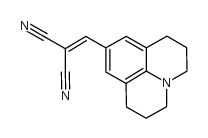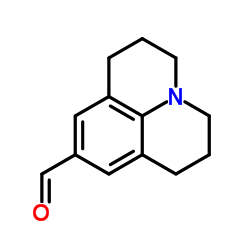9-(2,2-Dicyanovinyl)julolidine

9-(2,2-Dicyanovinyl)julolidine structure
|
Common Name | 9-(2,2-Dicyanovinyl)julolidine | ||
|---|---|---|---|---|
| CAS Number | 58293-56-4 | Molecular Weight | 249.31000 | |
| Density | 1.23 g/cm3 | Boiling Point | 470.7ºC at 760 mmHg | |
| Molecular Formula | C16H15N3 | Melting Point | N/A | |
| MSDS | Chinese USA | Flash Point | 214.6ºC | |
| Symbol |

GHS07 |
Signal Word | Warning | |
Use of 9-(2,2-Dicyanovinyl)julolidineDCVJ (9-(2,2-Dicyanovinyl)julolidine), a molecular rotor and unique fluorescent dye, binds to tubulin and actin, and increases its fluorescence intensity drastically upon polymerization. DCVJ also binds to phospholipid bilayers and increases its fluorescence intensity. DCVJ can detect the kinetic process of degranulation of mast cells[1]. |
| Name | 9-(2,2-Dicyanovinyl)julolidine |
|---|---|
| Synonym | More Synonyms |
| Description | DCVJ (9-(2,2-Dicyanovinyl)julolidine), a molecular rotor and unique fluorescent dye, binds to tubulin and actin, and increases its fluorescence intensity drastically upon polymerization. DCVJ also binds to phospholipid bilayers and increases its fluorescence intensity. DCVJ can detect the kinetic process of degranulation of mast cells[1]. |
|---|---|
| Related Catalog | |
| References |
| Density | 1.23 g/cm3 |
|---|---|
| Boiling Point | 470.7ºC at 760 mmHg |
| Molecular Formula | C16H15N3 |
| Molecular Weight | 249.31000 |
| Flash Point | 214.6ºC |
| Exact Mass | 249.12700 |
| PSA | 50.82000 |
| LogP | 2.88096 |
| Index of Refraction | 1.634 |
CHEMICAL IDENTIFICATION
HEALTH HAZARD DATAACUTE TOXICITY DATA
|
| Symbol |

GHS07 |
|---|---|
| Signal Word | Warning |
| Hazard Statements | H315-H319-H335 |
| Precautionary Statements | P261-P305 + P351 + P338 |
| Personal Protective Equipment | dust mask type N95 (US);Eyeshields;Gloves |
| Hazard Codes | Xi: Irritant; |
| Risk Phrases | 36/37/38 |
| Safety Phrases | 26-36 |
| RIDADR | NONH for all modes of transport |
| RTECS | OO4445000 |
| Precursor 2 | |
|---|---|
| DownStream 0 | |
|
Fluorescent molecular rotors: a new class of probes for tubulin structure and assembly.
Biochemistry 28 , 6678, (1989) 9-(Dicyanovinyl)julolidine (DCVJ) is a fluorescent dye whose intramolecular rotational relaxation is solvent dependent. Since its quantum yield increases with decreasing free volume, this molecule has... |
|
|
9-(Dicyanovinyl)julolidine binding to bovine brain calmodulin.
J. Biochem. 109 , 499, (1991) A molecular rotor, 9-(dicyanovinyl)julolidine (DCVJ), is a fluorescent dye whose intramolecular rotation determines its fluorescence yield [Kung, C.E. & Reed, J.K. (1989) Biochemistry 28, 6678-6686]. ... |
|
|
Antibodies for fluorescent molecular rotors.
Biochemistry 32 , 7589, (1993) We have prepared monoclonal antibodies for the fluorescent molecular rotors 9-(2-carboxy-2-cyanovinyl)julolidine (CCVJ) and 9-(dicyanovinyl)julolidine (DCVJ). Mouse monoclonal antibody (IgG2b) prepare... |
| dcvj |
 CAS#:33985-71-6
CAS#:33985-71-6 CAS#:109-77-3
CAS#:109-77-3